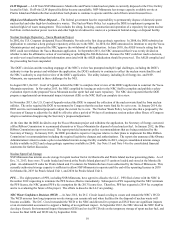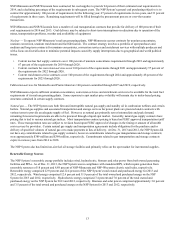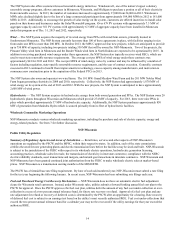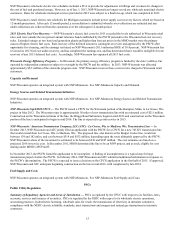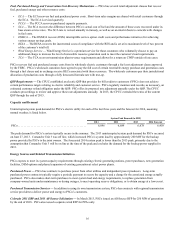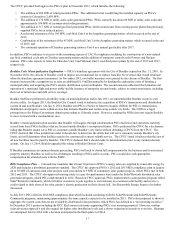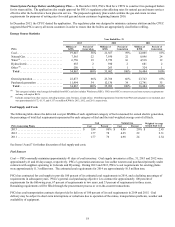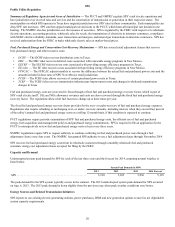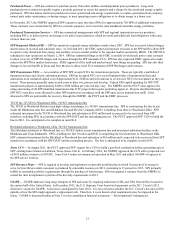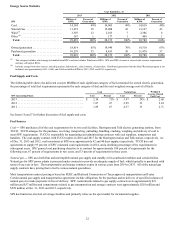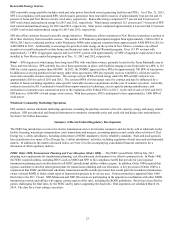Xcel Energy 2013 Annual Report Download - page 34
Download and view the complete annual report
Please find page 34 of the 2013 Xcel Energy annual report below. You can navigate through the pages in the report by either clicking on the pages listed below, or by using the keyword search tool below to find specific information within the annual report.
16
Fuel, Purchased Energy and Conservation Cost-Recovery Mechanisms — PSCo has several retail adjustment clauses that recover
fuel, purchased energy and other resource costs:
• ECA — The ECA recovers fuel and purchased power costs. Short-term sales margins are shared with retail customers through
the ECA. The ECA is revised quarterly.
• PCCA — The PCCA recovers purchased capacity payments.
• SCA — The SCA recovers the difference between PSCo’s actual cost of fuel and the amount of these costs recovered under its
base steam service rates. The SCA rate is revised annually in January, as well as on an interim basis to coincide with changes
in fuel costs.
• DSMCA — The DSMCA recovers DSM, interruptible service option credit costs and performance initiatives for achieving
various energy savings goals.
• RESA — The RESA recovers the incremental costs of compliance with the RES and is set at its maximum level of two percent
of the customer’s total bill.
• Wind Energy Service — Wind Energy Service is a premium service for those customers who voluntarily choose to pay an
additional charge to increase the level of renewable resource generation used to meet the customer’s load requirements.
• TCA — The TCA recovers transmission plant revenue requirements and allows for a return on CWIP outside of rate cases.
PSCo recovers fuel and purchased energy costs from its wholesale electric customers through a fuel cost adjustment clause approved
by the FERC. PSCo’s wholesale customers have agreed to pay the full cost of certain renewable energy purchase and generation costs
through a fuel clause and in exchange receive RECs associated with those resources. The wholesale customers pay their jurisdictional
allocation of production costs through a fully forecasted formula rate with true-up.
QSP Requirements — The CPUC established an electric QSP that provides for bill credits to customers if PSCo does not achieve
certain performance targets relating to electric reliability and customer service. PSCo regularly monitors and records, as necessary, an
estimated customer refund obligation under the QSP. PSCo files its proposed rate adjustment annually under the QSP. The CPUC
conducts proceedings to review and approve these rate adjustments annually. In 2013, the CPUC extended the terms of the current
QSP through the end of 2015.
Capacity and Demand
Uninterrupted system peak demand for PSCo’s electric utility for each of the last three years and the forecast for 2014, assuming
normal weather, is listed below.
System Peak Demand (in MW)
2011 2012 2013 2014 Forecast
PSCo . . . . . . . . . . . . . . . . . . . . . . . . . . . . . . . . . . . . . . . . . . . . . . . . 6,896 6,689 6,678 6,459
The peak demand for PSCo’s system typically occurs in the summer. The 2013 uninterrupted system peak demand for PSCo occurred
on June 27, 2013. Comanche Unit 3 was off line, which increased PSCo’s system load by approximately 260 MW for the backup
power provided by PSCo to the joint owners. The forecasted 2014 system peak is lower than the 2013 peak, primarily due to the
assumption that Comanche Unit 3 will be on line at the time of the peak and excludes the demand for the backup power supplied in
2013.
Energy Sources and Related Transmission Initiatives
PSCo expects to meet its system capacity requirements through existing electric generating stations, power purchases, new generation
facilities, DSM options and phased expansion of existing generation at select power plants.
Purchased Power — PSCo has contracts to purchase power from other utilities and independent power producers. Long-term
purchased power contracts typically require a periodic payment to secure the capacity and a charge for the associated energy actually
purchased. PSCo also makes short-term purchases to meet system load and energy requirements, to replace generation from
company-owned units under maintenance or during outages, to meet operating reserve obligations, or to obtain energy at a lower cost.
Purchased Transmission Services — In addition to using its own transmission system, PSCo has contracts with regional transmission
service providers to deliver power and energy to PSCo’s customers.
Colorado 2011 ERP and 2013 All-Source Solicitation — In March 2013, PSCo issued an All-Source RFP for 250 MW of generation
by the end of 2018. PSCo also issued a separate wind RFP for PPAs only.






